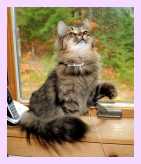The Siberian Breed And Origin
Siberians are hardy, friendly large cats with gentle dispositions and make wonderful life long friends. They have long hair and various markings. I specialize in silver tabbies and smokes and usually have other colors and patterns available. Come and visit us to pick your favorite from the current litter or reserve one from the next litter to come. Siberian kittens are $1000-$1200 and can be reserved with a non-refundable** deposit of $200. We occasionally have a grown cat for less, and do barter from time to time. Please view our wonderful sires, queens, and available kittens.
**Refunds are fully refundable should the reserved kitten become unavailable or if the new prospective owner is allergic to the kitten. A partial refund or carry-over of the deposit to a future litter can be made under extenuating circumstances.
An important note: The old bones in this body have been in trouble for several years and your breeder has gone through three hip replacements and now is a candidate for a repair of the other original replacement. Just getting old and having something called MGUS, I guess. As a result of this and our involvement with an attempt to develop and save the Tennessee Rex, a new breed I have adjourned breeding of Siberians and Maine Coons until after the next surgery. We have no Maine Coon or Siberian kittens available or in planning until much later in 2015. There is more about the Tennessee Rex in a chapter below about that breed included for your perusal in our Allpurrs Cattery web site.
.
Click on this link to watch at you-tube
(Sorry about any embedded advertising)

History
The Siberian is a native semi-longhair cat from northern Russia's and evolved from ancient origins. We believe that cats moved into Middle Asia along with traders plying this region. As the population expanded northward these cats developed the physical characteristics needed for survival in their less hospitable climates. The territory inhabited by this developing breed expanded along with expansion of the population. These semi-longhair triple coated domesticated cats moved north into Russia several centuries ago. The Siberian name implies a strong, resilient individual being capable of existing in the cold and unforgiving northern forests, an intelligent cat with dense fur. The Siberian has a triple coat of fur that is considered long hair by the Cat fancy but is not as long as say the Persian. These cats were welcomed by the inhabitants to protect their precious supplies of grain and other food crops during the long and cold seasons, surviving outdoors and hunting rodents that could jeopardize the food supplies. The friendly disposition of these cats was recognized and earned them a place in the lives, homes and hearts of their owners. These beautiful, large and powerful cats are still relatively rare in the United States
The cat was first mentioned in a book by Harrison Wier, which included information of the earliest cat shows in England in 1871. The cat was first imported to the US in June of 1990, by Elizabeth Terrell as an exchange for award winning pointed Persians.. The cat was first registered by the Kotofei cat club in St. Petersburg in 1987 and is now accepted by all the US registries. It was a change in attitude toward the Soviet Union with the collapse of Communism that spurred the acceptance of the breed and brought about ownership of these cats as pets here in the US.
It was also discovered that the cats either lack or have very little occurrence of a protein in their saliva. This protein is the major factor that causes allergic reaction by people sensitive to that protein. The cats transfer the protein to their fur while grooming. When the saliva dries the protein can become airborne and trigger allergic reactions in some people even if they do not handle them.
Prior to the collapse of the Soviet Union the Siberian-type cats roamed the streets of Russian cities including Moscow and St Petersburg. The market has brought about systematic breeding of these cats and they became the foundation population of the breed.
.
The Siberian cat
Known to be an exceptionally agile jumper, the Siberian is a strong and powerfully built cat, with strong hindquarters and large, well rounded paws, barrel chests and medium sized ears, broad foreheads, and stockier builds.
.

.
The Siberian Cat's Fur
Siberians express the three natural types of feline fur: guard hairs, awn hairs, and down. These three layers protected the cat from the Russian weather extremes, and provides a hearty, easy-to-care-for coat today. The fur is textured, but glossy, which means matting is rare. A twice-weekly combing is enough to keep the coat in good condition. As with many other cat breeds, color varieties of the Siberian vary and all colors, such as tabby, solid, tortoiseshell and colorpoint, are genetically possible. The Siberian cat breed does not have any unusual, distinct, or unique fur colorations or patterns. Some breeders, enthusiasts, organizations, and even registries and countries do not accept the colorpoint coloration as being natural. Colorpoint Siberians are also known as "Neva-Masquerade". Neva for the river where they are said to have originated, and masquerade, for the facial mask. The colorpoint is accepted in TICA and CFA.
.
TICA Breed Standard
Here is a link to the TICA breed standard. It may be a bit technical in detail. Pet quality kittens and cats may vary somewhat from the standard but will be a friendly member of the family.
